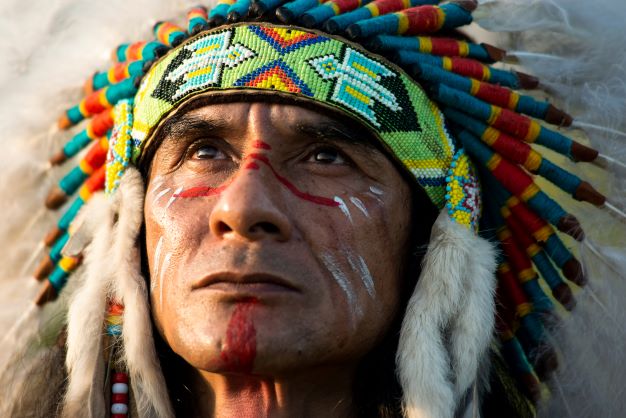
In November 2022, the Smithsonian’s National Museum of the American Indian dedicated the National Native American Veterans Memorial. The ceremony took place on the National Mall in Washington, D.C., as part of a three-day event to honor Native veterans.
The National Native American Veterans Memorial honors American Indians, Alaska Natives, and Native Hawaiian veterans who have served in the armed forces since the Revolutionary War.
It is located on the grounds of the National Museum of the American Indian and was unveiled on Veterans Day 2020.
In November 2021, the U.S. Department of Defense published a report on service members of Native American heritage who have been awarded the Medal of Honor, the highest medal for valor.
According to the Congressional Medal of Honor Society, 32 Native American and American Indian soldiers, sailors, airmen, marines, and coast guard members are part of the society.
In 2021, the number of active-duty personnel identifying as American Indian was 14,246, which represents 1.1% of the total military force, according to the Defense Manpower Data Center.
As part of the nation’s bicentennial commemoration in 1976, President Gerald Ford proclaimed October 10-16, 1976, as “Native American Awareness Week.”
Later, in 1986, President Ronald Reagan proclaimed November 23-30 as American Indian Week.
On November 14, 1990, President George H. W. Bush declared November as National American Indian Heritage Month to honor the diverse Native American tribes and people in the United States, including Alaska but excluding Hawaii.
In 2009, President Obama also proclaimed November as National Native American Heritage Month.
A Department of Labor survey conducted in 1995 asked American Indian participants about their preferred terms for identification.
The survey showed a split, with approximately 49.76% preferring the term “American Indian,” 3.5% preferring “Alaskan Native,” and about 37% preferring “Native American.”
Others expressed preferences for terms like “First Indigenous People” and “Original Peoples,” while some had no specific preference.
In 2020, the American Indian and Alaska Native population was approximately 3.7 million, accounting for 1.1% of the total population in the United States, an increase from 2.9 million, or 0.9%, in 2010.
Additionally, about 5.9 million people identified as American Indian and Alaska Native in combination with another racial group, such as White or Black.
In total, the American Indian and Alaska Native population, both alone and in combination with other races, comprised 9.7 million people, or 2.9% of the U.S. population in 2020, up from 5.2 million, or 1.7%, in 2010, according to the U.S. Census Bureau.
The significant increase in population from 2010 to 2020 can be attributed to improvements in the questions about origin and race, as well as how the bureau codes survey responses.
The National Museum of the American Indian was added to the Smithsonian Institution’s museums on the National Mall in Washington, D.C., in 2004.
It features exhibits on Native Americans from every state, including Hawaii, as well as indigenous peoples from around the world, primarily in the Western Hemisphere.
In 1924, Congress enacted the Indian Citizenship Act, which granted citizenship to all U.S.-born American Indians not already covered by treaties or other federal agreements. The act was later amended to include Alaska Natives as well.
The U.S. Army Corps of Engineers has been tasked with…
Brown and Caldwell, a leading environmental engineering and construction firm,…
Humboldt State University, one of four campuses within the California…